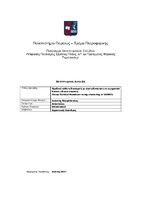| dc.contributor.advisor | Σκόνδρας, Εμμανουήλ | |
| dc.contributor.author | Κοσμόπουλος, Ιωάννης | |
| dc.date.accessioned | 2021-07-15T07:23:14Z | |
| dc.date.available | 2021-07-15T07:23:14Z | |
| dc.date.issued | 2021-06 | |
| dc.identifier.uri | https://dione.lib.unipi.gr/xmlui/handle/unipi/13561 | |
| dc.identifier.uri | http://dx.doi.org/10.26267/unipi_dione/984 | |
| dc.description.abstract | Η σταδιακή εγκαθίδρυση των δικτύων 5ης γενιάς αναβαθμίζει το ρόλο και τη χρήση των οχηματικών δικτύων. Ένα περιβάλλον υψηλής κινητικότητας, πολλαπλών απαιτήσεων και πληθώρας συσκευών, καλείται να ενστερνίζεται τα υπάρχοντα μοντέλα διαχείρισης της κινητικότητας. Οχήματα με υψηλή κινητικότητα καλούνται να είναι πάντα συνδεδεμένα στο δίκτυο που ικανοποιεί τις υπηρεσίες τους με το βέλτιστο τρόπο. Όμως, αυτή η ανάγκη αυξάνεται ραγδαία, επιβαρύνοντας το δίκτυο με τη διαχείριση της σηματοδοσίας και τη συνεχόμενη παρακολούθηση των οχημάτων κατά τη διαπομπή τους. Κατά συνέπεια, κρίνεται απαραίτητη η σχεδίαση ενός μηχανισμού διαπομπής για τα οχηματικά δίκτυα 5ης γενιάς μαζί με τη χρήση αλγόριθμων συσταδοποίησης για την ομαδοποίηση τους. Στην παρούσα εργασία προτείνεται ένας αλγόριθμος συσταδοποίησης και εκλογής της κεφαλής της συστάδας μαζί με ένα αποδοτικό σχήμα κάθετης ομαδικής διαπομπής (Group Vertical Handover, GVHO) για την πλήρη εφαρμογή του. Το εκάστοτε σημείο πρόσβασης ομαδοποιεί σε συστάδες την ακτίνα κάλυψης του, όπου η κεφαλή αυτής, πληρώντας όλα τα απαραίτητα κριτήρια, είναι υπεύθυνη για διαδικασίες αρχικοποίησης, επιλογής επόμενου δικτύου και ολοκλήρωσης της διαπομπής. Τα μέλη της συστάδας ενημερώνονται για την επικείμενη διαπομπή από την κεφαλή αλλά και μεταξύ τους με αποτέλεσμα να εγκαθιδρύουν το νέο κανάλι επικοινωνίας για την ανταλλαγή πακέτων άνω και κάτω ζεύξης. Το προτεινόμενο σχήμα εφαρμόζεται σε μια αρχιτεκτονική οχηματικού δικτύου επόμενης γενιάς αποτελούμενο από δίκτυα Long Term Evolution Advanced (LTE-A) , IEEE 802.16 Worldwide Interoperability for Microwave Access (WiMAX) macro και femto κυψέλες καθώς και IEEE 802.11p Wireless Access for Vehicular Environment (WAVE) Road Side Units (RSUs). Πειραματικά αποτελέσματα δείχνουν πως η προτεινόμενη μέθοδος υπερισχύει των υπαρχόντων σχημάτων διαπομπής. | el |
| dc.format.extent | 76 | el |
| dc.language.iso | el | el |
| dc.publisher | Πανεπιστήμιο Πειραιώς | el |
| dc.rights | Αναφορά Δημιουργού-Μη Εμπορική Χρήση-Όχι Παράγωγα Έργα 3.0 Ελλάδα | * |
| dc.rights | Αναφορά Δημιουργού-Μη Εμπορική Χρήση-Όχι Παράγωγα Έργα 3.0 Ελλάδα | * |
| dc.rights | Αναφορά Δημιουργού-Μη Εμπορική Χρήση-Όχι Παράγωγα Έργα 3.0 Ελλάδα | * |
| dc.rights.uri | http://creativecommons.org/licenses/by-nc-nd/3.0/gr/ | * |
| dc.title | Ομαδική κάθετη διαπομπή με συσταδοποίηση σε οχηματικά δίκτυα ειδικού σκοπού | el |
| dc.title.alternative | Group vertical handover using clustering in VANETs | el |
| dc.type | Master Thesis | el |
| dc.contributor.department | Σχολή Τεχνολογιών Πληροφορικής και Επικοινωνιών. Τμήμα Πληροφορικής | el |
| dc.description.abstractEN | The gradual establishment of 5th generation networks upgrades the role and use of vehicle networks. An environment of high mobility, multiple requirements, and a variety of devices, is called to embrace the existing models of mobility management. Vehicles with high mobility are required to always be connected to the network that satisfies their services in the best way. However, this need is growing rapidly, burdening the network with the management of signaling and the continuous monitoring of vehicles during their transmission. Therefore, it is necessary to design a transmission mechanism for the 5th generation vehicle networks together with the use of clustering algorithms for their grouping. In the present work, a clustering and selection algorithm of the cluster head is proposed together with an efficient Group Vertical Handover (GVHO) scheme for its full implementation. The respective access point groups its coverage radius into clusters, where its head, fulfilling all the necessary criteria, is responsible for initialization, next network selection and transmission completion processes. The members of the cluster are informed about the impending handover from the cluster head but also among themselves. As a result, they establish the new communication channel for the exchange of up and down link packets. The proposed scheme applies to a next-generation vehicle network architecture consisting of Long Term Evolution Advanced (LTE-A), IEEE 802.16 Worldwide Interoperability for Microwave Access (WiMAX) macro and femto cells, and IEEE 802.11p Wireless Access for Vehicular Environment (WAVE) Road Side Units (RSUs). Experimental results show that the proposed method outperforms existing handover schemes. | el |
| dc.contributor.master | Ψηφιακός Πολιτισμός, Έξυπνες Πόλεις, IoT και Προηγμένες Ψηφιακές Τεχνολογίες | el |
| dc.subject.keyword | 5G | el |
| dc.subject.keyword | VANETS | el |
| dc.subject.keyword | Mobility management | el |
| dc.subject.keyword | VHO | el |
| dc.subject.keyword | Clustering | el |
| dc.subject.keyword | FPMIPv6 | el |
| dc.date.defense | 2021-06 | |



